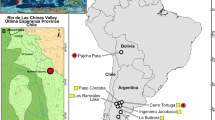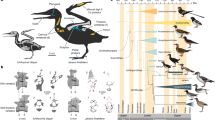Abstract
The origin of orangutans has long been debated. Sivapithecus is considered to be the closest ancestor of orangutans because of its facial–palatal similarities1, but its dental characteristics2 and postcranial skeleton2,3 do not confirm this phylogenetic position. Here we report a new Middle Miocene hominoid, cf. Lufengpithecus chiangmuanensis n. sp. from northern Thailand. Its dental morphology relates it to the Pongo clade, which includes Lufengpithecus4,5, Sivapithecus2, Gigantopithecus6, Ankarapithecus7 and possibly Griphopithecus8. Our new species displays striking dental resemblances with living orangutans and appears as a more likely candidate to represent an ancestor of this ape. In addition, it originates from the geographic area of Pleistocene orangutans. But surprisingly, the associated flora shows strong African affinities, demonstrating the existence of a temporary floral and faunal dispersal corridor between southeast Asia and Africa during the Middle Miocene, which may have played a critical role in hominoid dispersion.
This is a preview of subscription content, access via your institution
Access options
Subscribe to this journal
Receive 51 print issues and online access
$199.00 per year
only $3.90 per issue
Buy this article
- Purchase on Springer Link
- Instant access to full article PDF
Prices may be subject to local taxes which are calculated during checkout




Similar content being viewed by others
References
Pilbeam, D. New hominoid skull material from the Miocene of Pakistan. Nature 295, 232–234 (1982)
Ward, S. in Function, Phylogeny, and Fossils: Miocene Hominoid Evolution and Adaptations (eds Begun, D. R., Ward, C. V. & Rose, M. D.) 269–290 (Plenum, New York, 1997)
Pilbeam, D., Rose, M. D., Barry, J. C. & Shah, S. M. I. New Sivapithecus humeri from Pakistan and the relationship of Sivapithecus and Pongo. Nature 348, 237–239 (1990)
Wu, R. A revision of the classification of the Lufeng great apes. Acta Anthropol. Sin. 6, 263–271 (1987)
Harrison, T., Ji, X. & Su, D. On the systematic status of the Late Neogene hominoids from Yunnan Province, China. J. Hum. Evol. 43, 207–227 (2002)
Simons, E. L. & Chopra, S. R. K. Gigantopithecus (Pongidae, Hominoidea) A new species from north India. Postilla 138, 1–18 (1969)
Kappelman, J. et al. in Geology and Paleontology of the Sinap Formation (eds Fortelius, M., Kappelman, J., Bernor, R. & Sen, S.) (Columbia University Press, New York, in press)
Alpagut, B., Andrews, P. & Martin, L. New hominoid specimens from the Middle Miocene site at Pasalar, Turkey. J. Hum. Evol. 19, 397–422 (1990)
Barry, J. C. et al. Faunal and environmental change in the Late Miocene Siwaliks of northern Pakistan. Paleobiology Memoirs 3 (28), 1–71 (2002)
Morgan, M. E., Kingston, J. D. & Marino, B. D. Carbon isotopic evidence for the emergence of C4 plants in the Neogene from Pakistan and Kenya. Nature 367, 162–165 (1994)
Cerling, T. E. et al. Global vegetation change through the Miocene/Pliocene boundary. Nature 389, 153–158 (1997)
Pajunen, H. Proc. Symp. Int. Peat Soc., Jamaica, 25 February–1 March 1985 (ed. Heikurainen, L.) 186–197 (Int. Peat Soc., Helsinki, 1985)
Badgley, C., Guoqin, Q., Wanyong, C. & Defen, H. Paleoecology of a Miocene, tropical, upland fauna: Lufeng, China. Nat. Geogr. Res. 4, 178–195 (1988)
Hooijer, D. A. Prehistoric teeth of man and of the orang-utan from central Sumatra, with notes on the fossil orang-utan from Java and Southern China. Zool. Med. 29, 175–301 (1948)
Kelley, J. & Plavcan, J. M. A simulation test of hominoid species number at Lufeng, China: implications for the use of the coefficient of variation in paleotaxonomy. J. Hum. Evol. 35, 577–596 (1998)
Kelley, J., Anwar, M., McCollum, M. A. & Ward, S. C. The anterior dentition of Sivapithecus parvada, with comments on the phylogenetic significance of incisor heteromorphy in Hominoidea. J. Hum. Evol. 28, 503–517 (1995)
Wu, R. & Oxnard, C. E. Ramapithecines from China: evidence from tooth dimensions. Nature 306, 258–260 (1983)
Swarts, J. D. in Orangutan Biology (ed. Schwartz, J. H.) 263–270 (Oxford University Press, London, 1988)
Martin, L. Significance of enamel thickness in hominid evolution. Nature 314, 260–263 (1985)
Martin, L. The Relationships of the Later Miocene Hominoidea. Thesis, Univ. London (1983)
Schwartz, J. H. in Function, Phylogeny, and Fossils: Miocene Hominoid Evolution and Adaptations (eds Begun, D. R., Ward, C. V. & Rose, M. D.) 363–388 (Plenum, New York, 1997)
Schwartz, J. H. Lufengpithecus and its potential relationship to an orang-utan clade. J. Hum. Evol. 19, 591–605 (1990)
Harrison, T. & Rook, L. in Function, Phylogeny, and Fossils: Miocene Hominoid Evolution and Adaptations (eds Begun, D. R., Ward, C. V. & Rose, M. D.) 327–362 (Plenum, New York, 1997)
Remus, D., Webster, M. & Krawkan, K. Rift architecture and sedimentology of the Phetchabun intermontane basin, central Thailand. J. Southeast Asian Earth Sci. 8, 421–432 (1993)
Johnson, N. M. & McGee, V. E. Magnetic polarity stratigraphy: stochastic properties of data, sampling problems, and the evolution of interpretations. J. Geophys. Res. 88, 1213–1221 (1983)
Acknowledgements
We thank P. Andrews, L. de Bonis, J. Kappelman, J. Kelley and D. Pilbeam for comments, help, discussion and providing comparative materials; J. H. Schwartz and J. Kappelman for improving our manuscript; E. Boller, J. Baruchel and the ID 19 beamline staff of the European Synchrotron Radiation Facility (Grenoble, France) for their help in obtaining microtomographic images; A. Sritulakarn and N. Wongchai for providing facilities in Chiang Muan coal mine; B. Marandat for preparing fossils and making casts; H. Tong for translating Chinese documents; J. Barry, P. Tassy, G. Métais and S. Ducrocq for identifying associated large mammals. This work was supported by the Wenner-Gren and the Fyssen Foundations, the Department of Mineral Resources (Bangkok) and TRF-CNRS Project.
Author information
Authors and Affiliations
Corresponding author
Ethics declarations
Competing interests
The authors declare that they have no competing financial interests.
Rights and permissions
About this article
Cite this article
Chaimanee, Y., Jolly, D., Benammi, M. et al. A Middle Miocene hominoid from Thailand and orangutan origins. Nature 422, 61–65 (2003). https://doi.org/10.1038/nature01449
Received:
Accepted:
Issue Date:
DOI: https://doi.org/10.1038/nature01449
This article is cited by
-
Evolutionary ecology of Miocene hominoid primates in Southeast Asia
Scientific Reports (2022)
-
Clay mineralogy indicates a mildly warm and humid living environment for the Miocene hominoid from the Zhaotong Basin, Yunnan, China
Scientific Reports (2016)
-
Estimation of the ancestral effective population sizes of African great apes under different selection regimes
Genetica (2014)
Comments
By submitting a comment you agree to abide by our Terms and Community Guidelines. If you find something abusive or that does not comply with our terms or guidelines please flag it as inappropriate.



